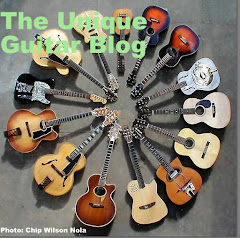When I started to play guitar, my Dad bought a Harmony Patrician from Will’s Pawn Shop for $20 USD. It came with heavy gauge Black Diamond strings, which were the only strings Will sold. Those strings were at least a half inch above the neck at the twelfth fret. It was difficult to play. The cheap open gear tuners were hard to turn and one of the tuning posts bent to the side. It was a better instrument than the ones some of my friends owned. At least it was made of solid wood.
Guitar technology has come a long way. CNC machines turn out exacting measurements on just about any instrument. Heavy strings are still available, but most of us choose light or medium gauge. However, some parts of a guitar differentiate a good guitar from a bad guitar.
The top is also book matched. A book matched top is made by sawing a plank of wood in half then reattaching the halves together. This enhances and evens out the grain of the wood. As the guitar gets older and is played, the vibrations produced on a solid guitar soundboard become more robust. This is the aging process.
The Seagull’s neck is made of silver leaf maple wood that is readily available. The feel of the neck may be a little bigger than on other guitars; however, the instrument is very playable and the slight bulk of the neck enhances the sound. The fretboard is made of Indian rosewood.
The neck is attaches to the guitar by two wooden dowels that come through the guitars heel and glued into the inner neck block. This eliminates glue between the heel and body, thus allowing a continuous wood-to-wood fit.
The headstock is unique in a couple of ways. The most obvious is the diamond shape taper. The purpose of this shape is to allow the strings to be pulled straight back instead of pulling to the side. This accomplishes two things. The string does not bind up at the nut, which will adversely affect tuning and the straight pull minimizes fatigue on the neck.
The other unique factor on the S6’s headstock is the way it attaches to the neck. The process is known as the reverse headstock. The neck starts out as a straight piece of lumber. Wood is sawn at a 45-degree angle at the top of the neck. The top piece is turned upside down, so the grain runs in the opposite direction and re-glued to the neck. Older guitars were made using this process.
High quality guitars costing four times as much as the Seagull utilize this technique.
A truss rod placed in the guitars neck is accessible for adjustment through the soundhole.
The last factor affecting the neck of the S6 is the pitch of the neck. An improper angle will cause the sound to be too thin or too muddy. Seagull utilizes a machine that adjusts the neck pitch perfectly.
The S6 is custom polished instead of spraying with a thick coat of polyester. The coat applied is similar to the French polish used on violins and some guitars. This method does not dampen the sound emanating from the guitars top.
A few comparable instruments to the Seagull are the Epiphone Masterbuilt line and the Taylor Big Baby. The Masterbuilt Epiphones are excellent guitars that are made entirely of solid wood. However most sell for at least $100 USD more than the Seagull S6.
The Taylor Big Baby is a large version of Taylor’s travel guitar. The top is solid spruce, but the back and sides are laminate. The neck screws into the neck block with two screws exposed at the 16th fret. There is no neck heel. The Big Baby is only slightly smaller than a full size guitar. It has a 15/16th scale. Despite these drawbacks, the Big Baby has a great sound and the factory set up is great. This instrument sells for about $50 more than the Seagull, but it does come with a gig bag.
| Sanding a saddle |
A benefit of Tusq is that it is very easy to work with and comparable to bone. You can also have the music stores repair department do this for you.
I would recommend before removing the saddle, place a mark on the lower side. The saddle is compensated. If you put it in backwards, you will not get the guitar in tune.
Seagull guitars are made in La Patrie, Quebec Canada and are owned by Robert Godin. Mr. Godin produces several other brands including Godin guitars (mostly electric instruments), Simon and Patrick guitars (named after his sons), La Patrie classical guitars, Norman guitars, and Arts, and Lutherie guitars (his budget line).
Looking at the inner sticker of a Seagull, you may note that it says "handmade." To some extent, this is true. Guitars are labour intensive and a lot of the work involves an individual working by hand to make the instrument. Most guitar manufacturers work this same way.
I do not want to diminish the quality of work these folks do. A truly handmade instrument by a luthier is something special, made by one individual, and is going to set you back a lot of money.
Perhaps the ultimate aspect that sets the S6 apart from other guitars, even those that are more expensive, is the Seagull's sound. The Seagull S6 has a boomy, but crisp tonal quality. It is a most excellent instrument for strumming or fingerpicking.
La Patrie is a small community in eastern Quebec. Godin employs almost half of the population.
Seagull guitars are wonderful instruments. I own a Seagull Grand, which is a parlor-sized guitar. I love the tone it produces. As I have said before, as these guitars get older, they sound better.
The S6 is the first guitar that Seagull produced back in 1982. It is not just an excellent instrument, but a great value as well.
©UniqueGuitar Publications (text only)





























